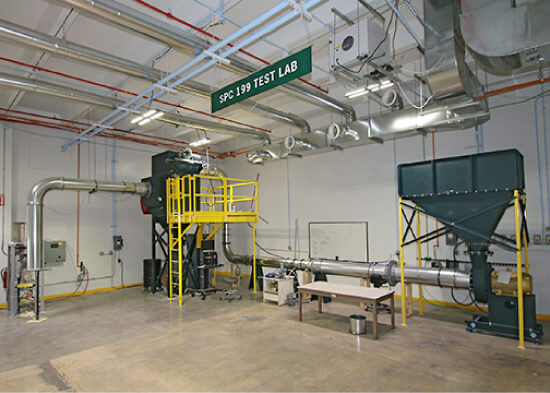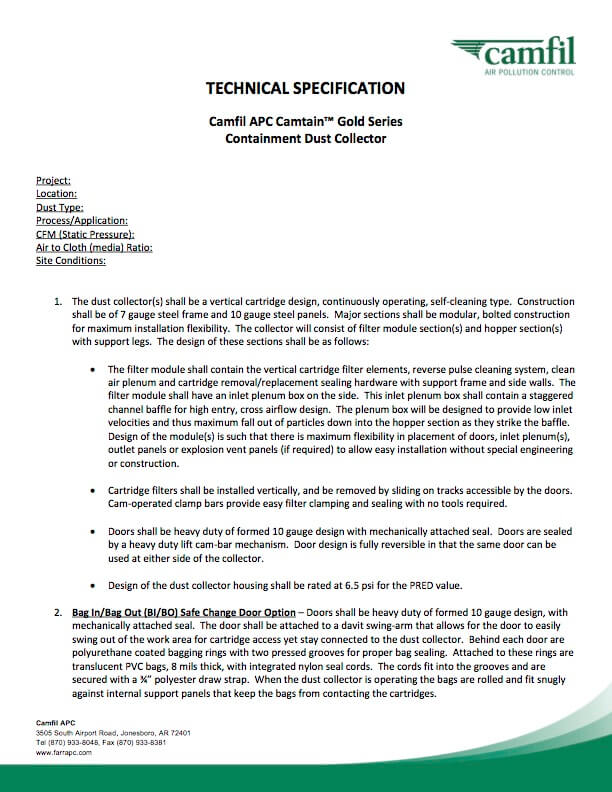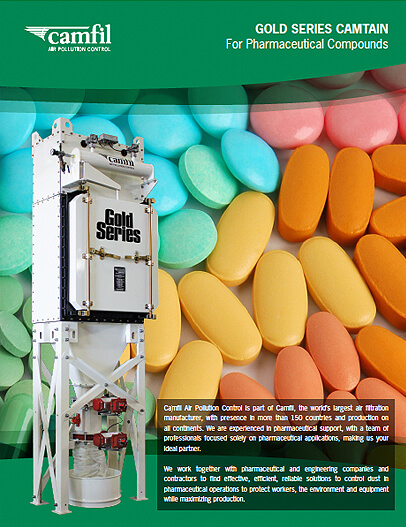A Dedicated Standard 199 Test Rig Eliminates Guesswork
Plugged filters, high emissions or other system problems are symptoms of poorly-functioning dust collectors. Industry experts estimate that 80% of all dust collectors do not operate satisfactorily. It’s a complex task to design and select dust collection equipment. It requires a comprehensive analysis of the dust or other airborne contaminant, system operating conditions, and many other factors. Yet all too often, equipment decisions are based on guesswork, so dust collectors don’t perform as expected.
Standard 199 testing compares dust collectors based on true operating conditions and real world performance data on emissions, pressure drop, compressed air usage, energy consumption and emission readings. The standard applies to industrial dust collectors that use pulse cleaning to recondition the filter media so the collector can continue to operate. Armed with this comparative data on operation, energy costs and particle emissions, you can make more informed long-term decisions to reduce maintenance, consumables and disposal costs.

Standard 199 Testing Stages
Standard 199 testing aims to challenge dust collectors in ways that mimic real-life use. The testing methodology requires use of calcium-carbonate dust with a specific particle size, bulk density, and moisture content, as outlined in the standard. The methodology includes six stages:
- Stage 1: Initial dust loading. Feed dust into the collector at the specified rate, without pulse cleaning, until the system reaches the specified differential pressure.
- Stage 2: Initial dust loading with on-demand cleaning. Begin on-demand pulse cleaning while continuing to feed more dust at the same airflow. The high and low differential-pressure set points determine the cleaning interval. Pulse cleaning is the most common filter-cleaning method that the pharmaceutical industry uses.
- Stage 3: Dust loading with continuous cleaning. Maintain the airflow and dust feed and continue to pulse-clean the filters at routine intervals for 24 hours or until the system reaches the specified maximum differential pressure.
- Stage 4: Final dust loading with on-demand cleaning. Test the final dust loading with on-demand cleaning by maintaining the airflow and dust feed. As with Stage 2, the high and low differential-pressure set points trigger the filter cleaning, the frequency of which varies depending on the system’s performance and pressure buildup.
- Stage 5: Upset condition. Maintain the dust feed while suspending pulse cleaning to mimic how the dust collector would perform in an upset condition.
- Stage 6: Post-upset condition. Replicate the downtime cleaning process to simulate a post-upset scenario to return the system to normal operation.
Standard 199 Dust Collector Performance Parameters
Differential Pressure
As measured by pound per square inch (Psig) gauge, differential pressure is the energy required to move a given volume of water through a system. Higher differential pressure readings mean higher operational costs. A well-designed primary filter for a dust collector, manufactured properly, can release dust during the reverse-pulse cleaning cycle and reduce cleaning frequency, which helps the system maintain a low pressure drop throughout the service life of the filter.
Absolute Emissions
As measured in milligrams per cubic meter of air or mg/m3, measures how much material passes through the dust collector filters during normal operations. Measuring emissions potentially helps meet certain EPA regulations.
Compressed Air Consumption
As measured in ft3/1000ft3, the amount of compressed air consumed can be used as an indicator for the amount of energy required to power the pulse cleaning system. This measurement indicates the effectiveness of the self-cleaning system because more efficient pulse cleaning consumes less compressed air.
Overall Energy Consumption
As measured by kWh over the time of the test, less energy used means lower overall energy costs. Energy is required to run the dust collector’s filter pulse cleaning system, the fan that pulls air through the system and the variable frequency drive that helps to maintain a constant air flow and static pressure. More efficient pulse cleaning and lower average pressure drop across the filters reduces the amount of energy required by the fan, extends the service life of the filter and reduces overall energy consumption.
 Americas
Americas 
